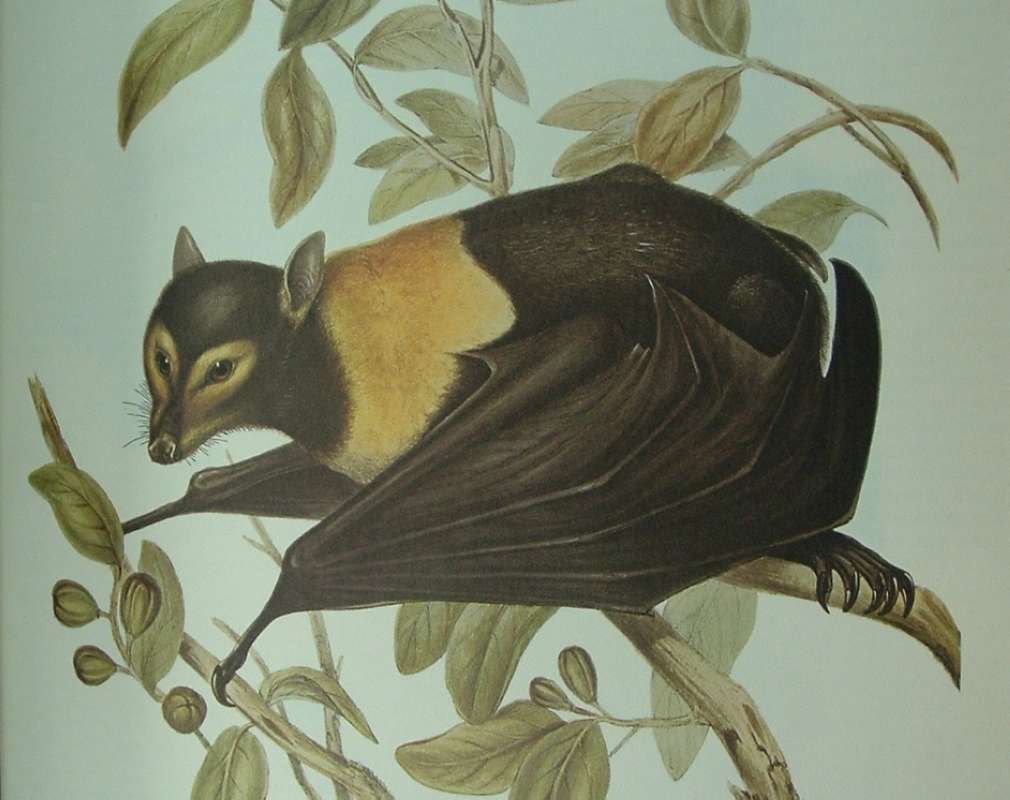SPECIES INFO
Spectacled flying-fox (Pteropsis conspiculatus) is found in New Guinea and in Australia in lowland coastal areas of northern Queensland. This is a rain forest species. This species can be easily recognized by its pale fur on the back of its neck. Furthermore, the pale area around the eyes is also distinctive. In spite of the fact this species feeds on fruits, it has a well developed set of almost canine teeth. The head and body length is from about 8 to 10 inches.Pteropodidae, flying foxes, is a large family of over 170 species that is found from Africa east through warmer Asia through Indonesia to Australia. Many species have a face that reminds one of a dog. Most species live on plant material, especially wild fruits, pollen and nectar. Some species form large colonies of up to a million individuals. Certain of the larger species have wingspans in excess of five feet.
We have seen the family name Megachiroptera used for the group of flying foxes. Most species are considered excellent human food, and are in danger of over exploitation.
In 2005 Wilson-Reeder counted 186 species distributed among 42 different genera.
Bats (Order Chiroptera) are typically night-flying mammals that navigate by sending out sound waves and listening to their echoes. There are two main groups: the giant fruit eating bats (including the flying foxes), and the smaller typical bats. There appears to be over 1,000 known species of bats that have been placed in almost twenty different families. In 2005 Wilson-Reeder found 1,116 species distributed among 202 genera.
Most bats spend the day hanging upside down in caves or abandoned buildings. Their fingers support a skin like membrane that performs the same function as wing feathers in birds.
Mammals (Class Mammalia), together with the birds, are among the youngest of the classes of animals. In species count, mammals number about fifty-one hundred, trailing reptiles (approximately fifty-five hundred), fish (approximately eighteen thousand), and birds (approximately eighty-six hundred).
There are three sub-types of mammals:
monotremes, the most primitive:
Develop in reptilian-like eggs and suckle milk emerging
(i.e., spiny anteater, duckbilled platypus)
marsupials
Newborn emerges very underdeveloped and continue to
mature in a pouch on its mother's abdomen (i.e., opossums,
koala, kangaroo)
placental
Embryo develops within the uterus of the female and is
dependent on a placenta for nutrition and waste removal
(i.e., humans, lions, monkeys)
About sixty-five million years ago, the Tertiary era produced thirty-five orders of mammals. Of this number, eighteen have survived to represent Earth's most diversified as well as its most highly developed classification of animals.
Extinction of mammals is fast becoming a serious issue. Duff and Lawson present a list of forty-one extinct species that reached extinction prior to 1800. These forty-one species are not acknowledged in the counts of the various families. Duff and Lawson also present a list of forty-six species including three gazelles, one zebra, one seal, one deer, and one wolf that have probably gone extinct since 1800. These forty-six species are included in the family counts. Science is adding about forty to fifty new species a year to the list. Many of these are the result of divisions of prior species; some are recent discoveries.
Mammals owe their survival to adaptive capabilities that include the ability to exploit whatever sources of food are available to them, as well as their ability to adjust to various climes. Food specialization influenced evolution to such a great extent that the teeth structure can and has been used to provide extensive information on the food needs and various lifestyles of extinct species.
Despite the vast diversity among mammals in terms of size, habitats and adaptations, they share without exception many characteristics such as:
a. body hair
b. mammary glands
c. certain skull characteristics
d. four limbs that permit speed
e. parallel not perpendicular limbs
f. compartmentalized internal organs
g. a four-chambered heart and pulmonary circulation
Backboned Animals (Phylum Chordata) are the most advanced group of animals on earth. These animals are characterized by having a spinal cord or backbone. Most members have a clearly defined brain that controls the organism through a spinal cord. Fish, amphibians, reptiles, birds, and mammals are in this phylum.
Currently, some taxonomists believe that the fish should be divided into two groups (sharks and regular fishes) and that there are some other primitive groups in the phylum such as hagfish or lampreys.
Animal Kingdom contains numerous organisms that feed on other animals or plants. Included in the animal kingdom are the lower marine invertebrates such as sponges and corals, the jointed legged animals such as insects and spiders, and the backboned animals such as fish, amphibians, reptiles, birds, and mammals.

